Shipping goods across the world doesn’t have to be expensive or complicated. That’s where sea freight forwarding comes in. It’s one of the most reliable, affordable, and eco-friendly ways to move cargo in bulk. In this blog, we break down the benefits of using sea freight, how it compares to air freight, what kinds of goods work best, and how businesses can choose the right forwarding partner to streamline global trade.
- Key Takeaways
- Top Benefits of Using Sea Freight Forwarding
- 1. Cost-Effective for Bulk & Long-Distance Shipments
- 2. High Cargo Capacity
- 3. Safe and Reliable
- 4. Environmentally Friendly
- 5. Handles All Cargo Types
- 6. Global Reach
- 7. Reduced Risk of Damage
- Additional Advantages of Sea Freight Forwarding
- Lower Maintenance and Handling Costs
- Strong Support from Freight Forwarders
- Industry-Based Benefits of Sea Freight Forwarding
- Retail and E-Commerce
- Manufacturing and Industrial
- Automotive and Spare Parts
- Agriculture and Food Commodities
- Construction and Infrastructure
- Oil, Gas, and Energy
- Business Growth Benefits of Sea Freight Forwarding
- Lower Shipping Costs Mean Better Profit Margins
- Access to Global Markets
- Bulk Shipping Supports Expansion
- Reliable Schedules for Better Planning
- Strengthens Supplier and Customer Relationships
- What is Sea Freight Forwarding and Why Does It Matter for Global Trade
- Why Sea Freight Forwarding is Crucial
- What Does a Sea Freight Forwarder Do?
- What Goods Are Best for Sea Freight?
- How Much Does Sea Freight Cost?
- Are There Any Disadvantages?
- Sea Freight vs Air Freight: Which Should You Choose?
- Verdict:
- Common Myths About Sea Freight
- How to Choose the Right Sea Freight Forwarder
- Conclusion
- FAQs About Sea Freight Forwarding
- What Are the Benefits of Ocean Freight?
- How long does sea freight take?
- Can I track my shipment in sea freight forwarding?
Key Takeaways
- Sea freight is the most cost-effective way to ship large or bulk goods, particularly over long distances.
- Businesses of all sizes can use sea freight, thanks to flexible options such as LCL (Less Than Container Load).
- Sea freight has a lower environmental impact than air freight, making it a smarter choice for sustainable shipping.
Top Benefits of Using Sea Freight Forwarding
Shipping goods across the globe doesn’t have to be costly or complicated. Sea freight forwarding offers a practical, affordable, and reliable way to move cargo internationally, especially for bulk and heavy loads. Here’s a simplified look at the top benefits of using sea freight forwarding:
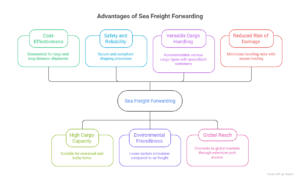
1. Cost-Effective for Bulk & Long-Distance Shipments
Sea freight is reasonable than air, especially for large shipments. Businesses can send large volumes at low costs, making it ideal for budget management over long distances.
2. High Cargo Capacity
Ships are the most suitable means of transporting goods that are oversized, heavy, or bulky, which cannot be transported by air. Full Container Load (FCL) and Less than Container Load (LCL) options allow you to select what fits your cargo best.
3. Safe and Reliable
Containers are sealed, secured and made for long sailing. A reliable freight forwarder ensures documentation, tracking and compliance for safe and secure shipping.
4. Environmentally Friendly
Sea freight is a greener choice because it emits less CO₂ per ton compared to air. As a result businesses focused on sustainability often prefer ocean freight.
5. Handles All Cargo Types
Whether it’s machinery, perishables, liquids, or irregular-sized items, sea freight can handle it with the right container type, like reefers, flat racks, or tanks.
6. Global Reach
With worldwide port access and trade route options, sea freight connects you to global markets. It also supports multimodal logistics when needed.
7. Reduced Risk of Damage
Goods are securely loaded and moved less frequently, reducing handling risks. Container systems and professional port procedures help keep cargo safe.
Additional Advantages of Sea Freight Forwarding
Sea freight forwarding is indeed not only beneficial in terms of cost savings and capacity, but it also offers a lot of other benefits which are frequently underestimated. These additional advantages of sea freight forwarding turn it into a sustainable, wise decision for a wide range of businesses, particularly those operating in the global logistics sector.
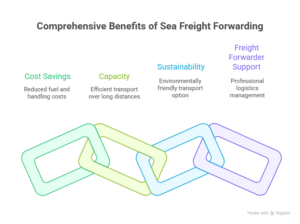
Lower Maintenance and Handling Costs
Ships are highly efficient over long distances, requiring less fuel per container and minimal handling once loaded. This leads to lower operational and labor costs, which are passed on to shippers.
Strong Support from Freight Forwarders
Professional freight forwarders simplify logistics by handling:
- Booking and scheduling
- Customs clearance
- Insurance and documentation
- Port coordination
Their expertise guarantees smooth operations from pickup to delivery.
Industry-Based Benefits of Sea Freight Forwarding
Sea freight forwarding isn’t just for one type of business. It works across industries thanks to its affordable pricing, high cargo capacity, and global reach. Here’s how different sectors benefit:
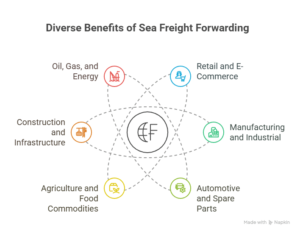
Retail and E-Commerce
Online stores and retailers often ship bulk items such as clothes, gadgets, and furniture across borders.
Sea freight forwarding helps by:
- Offering low-cost bulk shipping, keeping profit margins healthy.
- Supporting LCL shipping, ideal for smaller stock levels.
- Enabling frequent restocking without high transport costs.
Manufacturing and Industrial
Factories rely on importing raw materials or exporting heavy machinery.
Sea freight forwarding makes it easier by:
- Using FCL containers for large machines or tools.
- Offering safe handling of oversized or break-bulk cargo.
- Ensuring regular, high-volume shipments for smooth production.
Automotive and Spare Parts
From engines to tires, the auto sector depends on reliable cargo flow.
Benefits of ocean freight shipping include:
- Cost-effective bulk shipping of parts.
- Consistent schedules for just-in-time delivery.
- Containers that can be climate-controlled or secured.
Agriculture and Food Commodities
Whether it’s grains or oils, shipping agricultural goods overseas requires care.
Sea freight forwarding supports this sector with:
- Reefer containers for perishables.
- Low-cost transport for bulk exports.
- Flexible solutions for cross-border trade.
Construction and Infrastructure
This sector ships big, heavy items like steel and prefab panels.
Sea freight forwarding is ideal because it:
- Moves heavy, oversized cargo safely.
- Allows full batches to ship via FCL containers.
- Maintain low costs for large-scale projects.
Oil, Gas, and Energy
Shipping pipelines, drilling tools, or chemicals? This industry needs special handling.
Ocean freight shipping helps by:
- Providing custom container solutions and safety protocols.
- Supporting bulk movement of large and hazardous items.
- Ensuring port documentation and global compliance.
Business Growth Benefits of Sea Freight Forwarding
If your business relies on international trade, then sea freight forwarding can be more than just a means to transport goods from one place to another. It can be the driving force behind your growth, faster, efficient, and less problematic. Here is how it makes it happen:
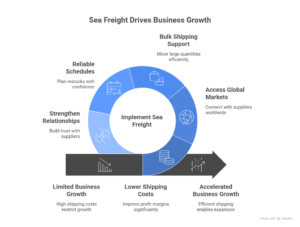
Lower Shipping Costs Mean Better Profit Margins
Shipping by sea is usually way cheaper than air, especially for big or heavy items. That means:
- You spend less on logistics.
- You can offer better prices to customers—or just keep more profit.
- You can expand into new markets without blowing your budget on freight.
For startups or growing brands, this makes a huge difference. It’s like getting more room to breathe and scale.
Access to Global Markets
With ocean freight shipping, the world’s pretty much open to you. Whether you’re importing fabrics from India or exporting kitchenware to Europe:
- You can connect with suppliers or customers anywhere.
- Your business isn’t limited by geography.
- Freight forwarders handle the tricky part—customs, paperwork, port clearances—so you don’t have to be a shipping expert to go global.
Bulk Shipping Supports Expansion
Let’s say your business suddenly takes off. More orders, more stock needed, more everything. Sea freight services help you:
- Move large quantities of goods at once.
- Get better rates per unit as volume increases.
- Come up with long-term inventory plans, which will ensure that you have sufficient stock even at the busiest times of the year
In essence, you can’t outgrow sea freight- it just expands along with your business.
Reliable Schedules for Better Planning
Ocean shipping may not be the fastest, but it’s predictable. You get fixed sailing plans, consistent transit times, and tracking options.
- It helps you plan restocks, promotions, and launches with more confidence.
- When combined with a reliable freight forwarding company in Dubai, you get even more control and updates.
Strengthens Supplier and Customer Relationships
When your shipping is stable, your whole supply chain becomes smoother. That builds trust:
- Suppliers know you can handle large orders and transport them on time.
- Customers trust that you’ll deliver what they ordered when you promised.
What is Sea Freight Forwarding and Why Does It Matter for Global Trade
Sea freight forwarding means moving goods by ocean in a safe, planned, and cost-effective way. A sea freight forwarder takes care of all the tasks that include arranging space on a ship, paperwork for customs, port charges and delivery to the final destination.
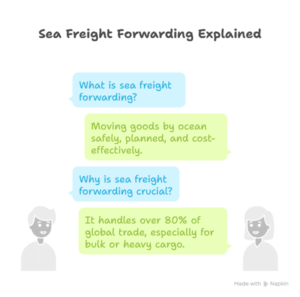
Why Sea Freight Forwarding is Crucial
Over 80% of global trade happens by sea. Whatever the nature of the goods – raw materials, food products, or machinery, sea freight is the lifeline of global industries. It is the backbone of international logistics, particularly for bulk or heavy cargo.
What Does a Sea Freight Forwarder Do?
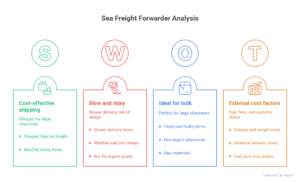
A freight forwarder makes ocean shipping smoother by handling:
- Cargo booking with shipping lines
- Paperwork like a bill of lading, a packing list, and an invoice
- Customs clearance and local transport
- Shipment tracking and coordination
The Sea Freight Forwarder must ensure that your goods are delivered safely, on time, and in compliance with the law.
What Goods Are Best for Sea Freight?
Sea freight is ideal for:
- Heavy and bulky items (equipment, vehicles)
- Non-urgent shipments
- Raw materials and industrial goods
- Refrigerated cargo via reefer containers
If the cargo is huge and not time-sensitive, sea freight is the perfect choice.
How Much Does Sea Freight Cost?
Cost depends on:
- Volume and weight (CBM or container type)
- Distance between ports
- Fuel, port fees, customs duties
Compared to air, sea freight is far cheaper. They are perfect for large shipments, though it takes more time.
Are There Any Disadvantages?
- Slower delivery (weeks instead of days)
- Risk of weather delays or port congestion
- Not ideal for high-value or urgent goods
Still, for most bulk shipments, the cost savings make it worth the wait.
Sea Freight vs Air Freight: Which Should You Choose?
When it comes to choosing between sea freight and air freight, businesses often face a dilemma. It isn’t that one is better than the other; it is that which is right for you depends on what you are shipping, how much money you are willing to put out, and how quickly you need them delivered. To make it easier, here’s a comparison of both options:
| Factor | Sea Freight | Air Freight |
| Speed vs Cost | Slower, but much cheaper | Fast, but expensive |
| Environmental Impact | Eco-friendly and fuel-efficient | High carbon emissions |
| Use Cases | Best for bulky, non-urgent cargo | Great for urgent, high-value goods |
| Hybrid Strategies | Can be combined with air for flexibility | Often used for time-sensitive components |
Verdict:
- Choose sea freight for cost savings and bulk cargo.
- Choose air freight when speed matters.
Common Myths About Sea Freight
- “It’s always slow.”Some sea routes are optimized and predictable
- “Tracking is impossible.”Most carriers provide end-to-end shipment tracking today
- “Only for big businesses”: SMEs can ship via LCL or with freight forwarder support
- “Sea freight is outdated.”It remains the most widely used shipping method globally
How to Choose the Right Sea Freight Forwarder
When deciding how to choose the right sea freight forwarder
- Check industry experience and reputation
- Ensure global network and port partnerships
- Confirm licensing and compliance capabilities
- Look for technology integration and shipment tracking
- Compare pricing, transparency, and customer service
Conclusion
Sea freight forwarding is one of the best options for global trade. This logistics solution stands out as an excellent choice for businesses of all sizes because it combines cost-effectiveness with high cargo capacity while being eco-friendly and offering global reach. Partnering with a reliable freight forwarder like Triroute Shipping, a trusted freight forwarding company in Dubai, ensures operational efficiency, boosts customer satisfaction, and facilitates international business expansion.
FAQs About Sea Freight Forwarding
What Are the Benefits of Ocean Freight?
Affordability, scalability for large volumes, and low environmental impact.
How long does sea freight take?
Transit times range from 5 to 45 days depending on origin, destination, and carrier schedules.
Can I track my shipment in sea freight forwarding?
Yes. Most modern carriers and freight forwarders offer real-time tracking and shipment updates.






